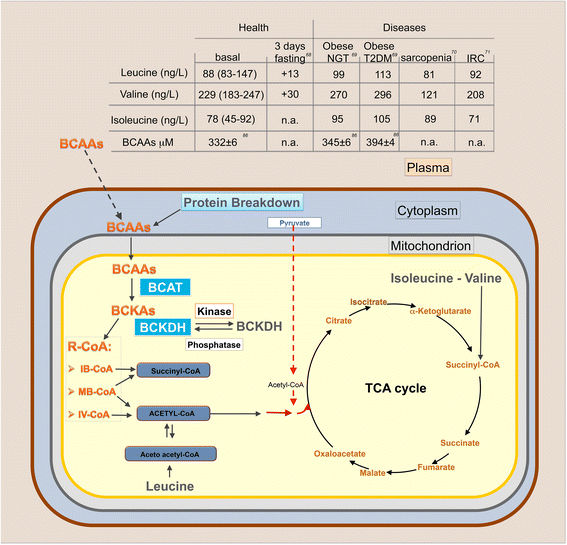Amino acid supplements and metabolic health: a potential interplay between intestinal microbiota and systems control
- PMID: 29043007
- PMCID: PMC5628494
- DOI: 10.1186/s12263-017-0582-2
Amino acid supplements and metabolic health: a potential interplay between intestinal microbiota and systems control
Abstract
Dietary supplementation of essential amino acids (EAAs) has been shown to promote healthspan. EAAs regulate, in fact, glucose and lipid metabolism and energy balance, increase mitochondrial biogenesis, and maintain immune homeostasis. Basic science and epidemiological results indicate that dietary macronutrient composition affects healthspan through multiple and integrated mechanisms, and their effects are closely related to the metabolic status to which they act. In particular, EAA supplementation can trigger different and even opposite effects depending on the catabolic and anabolic states of the organisms. Among others, gut-associated microbial communities (referred to as gut microbiota) emerged as a major regulator of the host metabolism. Diet and host health influence gut microbiota, and composition of gut microbiota, in turn, controls many aspects of host health, including nutrient metabolism, resistance to infection, and immune signals. Altered communication between the innate immune system and the gut microbiota might contribute to complex diseases. Furthermore, gut microbiota and its impact to host health change largely during different life phases such as lactation, weaning, and aging. Here we will review the accumulating body of knowledge on the impact of dietary EAA supplementation on the host metabolic health and healthspan from a holistic perspective. Moreover, we will focus on the current efforts to establish causal relationships among dietary EAAs, gut microbiota, and health during human development.
Keywords: Aging; Branched-chain amino acids; Diabetes; Essential amino acids; Gut microbiota; Healthspan; Microbes; Obesity; Short-chain fatty acids; Supplement.
Conflict of interest statement
Ethics approval and consent to participate
Not applicable.
Consent for publication
Not applicable.
Competing interests
The authors declare that they have no competing interests.
Publisher’s Note
Springer Nature remains neutral with regard to jurisdictional claims in published maps and institutional affiliations.
Figures


Similar articles
-
Bacteroides fragilis aggravates high-fat diet-induced non-alcoholic fatty liver disease by regulating lipid metabolism and remodeling gut microbiota.Microbiol Spectr. 2024 Apr 2;12(4):e0339323. doi: 10.1128/spectrum.03393-23. Epub 2024 Feb 27. Microbiol Spectr. 2024. PMID: 38411057 Free PMC article.
-
Dietary Fiber, Gut Microbiota, and Metabolic Regulation-Current Status in Human Randomized Trials.Nutrients. 2020 Mar 23;12(3):859. doi: 10.3390/nu12030859. Nutrients. 2020. PMID: 32210176 Free PMC article.
-
Metabolic shifts and structural changes in the gut microbiota upon branched-chain amino acid supplementation in middle-aged mice.Amino Acids. 2016 Dec;48(12):2731-2745. doi: 10.1007/s00726-016-2308-y. Epub 2016 Aug 18. Amino Acids. 2016. PMID: 27539648
-
Functional changes of the gastric bypass microbiota reactivate thermogenic adipose tissue and systemic glucose control via intestinal FXR-TGR5 crosstalk in diet-induced obesity.Microbiome. 2022 Jun 24;10(1):96. doi: 10.1186/s40168-022-01264-5. Microbiome. 2022. PMID: 35739571 Free PMC article.
-
Improving healthspan via changes in gut microbiota and fermentation.Age (Dordr). 2015 Oct;37(5):98. doi: 10.1007/s11357-015-9817-6. Epub 2015 Sep 14. Age (Dordr). 2015. PMID: 26371059 Free PMC article. Review.
Cited by
-
Protein-Rich Flours from Quinoa and Buckwheat Favourably Affect the Growth Parameters, Intestinal Microbial Activity and Plasma Lipid Profile of Rats.Nutrients. 2020 Sep 11;12(9):2781. doi: 10.3390/nu12092781. Nutrients. 2020. PMID: 32932953 Free PMC article.
-
International Society of Sports Nutrition Position Stand: Effects of essential amino acid supplementation on exercise and performance.J Int Soc Sports Nutr. 2023 Dec;20(1):2263409. doi: 10.1080/15502783.2023.2263409. Epub 2023 Oct 6. J Int Soc Sports Nutr. 2023. PMID: 37800468 Free PMC article.
-
Gut barrier and microbiota changes with glycine and branched-chain amino acid supplementation in chronic haemodialysis patients.J Cachexia Sarcopenia Muscle. 2021 Dec;12(6):1527-1539. doi: 10.1002/jcsm.12781. Epub 2021 Sep 18. J Cachexia Sarcopenia Muscle. 2021. PMID: 34535959 Free PMC article. Clinical Trial.
-
Mung Bean Functional Protein Enhances Endothelial Function via Antioxidant Activity and Inflammation Modulation in Middle-Aged Adults: A Randomized Double-Blind Trial.Foods. 2024 Oct 28;13(21):3427. doi: 10.3390/foods13213427. Foods. 2024. PMID: 39517211 Free PMC article.
-
Effect of You-Gui-Wan on House Dust Mite-Induced Mouse Allergic Asthma via Regulating Amino Acid Metabolic Disorder and Gut Dysbiosis.Biomolecules. 2021 May 30;11(6):812. doi: 10.3390/biom11060812. Biomolecules. 2021. PMID: 34070764 Free PMC article.
References
-
- D'Antona G, Ragni M, Cardile A, Tedesco L, Dossena M, Bruttini F, Caliaro F, Corsetti G, Bottinelli R, Carruba MO, et al. Branched-chain amino acid supplementation promotes survival and supports cardiac and skeletal muscle mitochondrial biogenesis in middle-aged mice. Cell Metab. 2010;12(4):362–372. - PubMed
-
- Nisoli E, Cozzi V, Carruba MO. Amino acids and mitochondrial biogenesis. Am J Cardiol. 2008;101(11A):22E–25E. - PubMed
Publication types
LinkOut - more resources
Full Text Sources
Other Literature Sources

